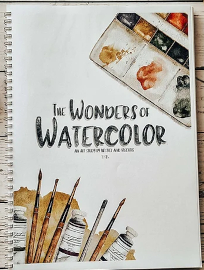The Wonders of Watercolor is a standalone PDF book that teaches watercolor techniques, the first in a planned series of three books that will include Watercoloring Our World and Watercoloring Our Lives. The Wonders of Watercolor can be viewed on a screen or printed out in color, but it is not a workbook.
It teaches basic techniques as well as special effects, making it suitable for ages ten through adults, beginners as well as those with some experience. As the author says on page 5, “My main goal for you in this book is to experiment and find new ways to approach watercolors and to begin to make your own path as an artist.” As you might expect, the book is beautifully illustrated throughout by the author, identified as Betsy.
This 121-page book has six sections:
- Introduction & Materials
- Value Scale
- Texture & Strokes
- Wet on Wet
- Wet on Dry
- Additional Projects
The Introduction & Materials section discusses paper, pencils, paints (pans and tubes), and paper, as well as optional items like washi tape and masking fluid. Betsy suggests variously priced options for art resources, pointing out where quality matters and where you can skimp. She includes links to specific products you might consider on Amazon, although you can purchase from any source.
After Introduction & Materials, each section has illustrated instructions and practice exercises, followed by projects. Instructions for projects are thorough, showing processes step-by-step. Students will need to draw or sketch shapes on their watercolor paper, and younger students might need some assistance with sketching.
Instruction and Projects
In the Value Scale section, Betsy has students explore the array of values for each paint color, whether pan or tube. In this exercise, students create strips for each color in their collection of paints, creating five values per color by varying the amount of water. This exercise helps students judge in advance the amount of water needed to create a color value before beginning to paint. Students then tackle a small project using simple designs provided in the book or making up their own, and then painting with only one color, using three or four values. The next project shows simple designs for abstract beach and mountain scenes that students are to paint with three colors, applied in distinctly different values.
Texture & Strokes begins with a texture exercise that can be completed in 12 small squares on a single sheet of paper. They begin with a single wash of paint and advance from there into techniques such as “dark color bloom” created by adding drops of a darker color on a previously painted swatch, and creating other types of blooms with water, rubbing alcohol, and salt. Paper towels, plastic wrap, a credit card, soap bubbles, and rice are also used to create other special effects. In this section of the book, Betsy also teaches brush techniques to create straight lines, irregular lines, shapes that vary in width, curved shapes, and dots. For the projects, students create what could be the fronts of note cards using some of these techniques.
Wet on Wet teaches techniques for painting on wet surfaces, whether wet from water or a previously painted area. Students apply techniques while painting bubbles, a pear, popsicles, and a gift box. This is where students learn more about blending colors.
Wet on Dry is a more controlled method of painting in which colors are purposely kept from blending. Students practice and then tackle a simple botanical scene, stalks of wheat, and poppies.
Additional Projects has students combine skills from the various lessons to paint a manta ray, striped flip-flops, a colorful bunch of carrots, a flowering prickly pear, a butterfly, a cupcake, and a llama.
Summary
The Wonders of Watercolor offers scope for beginners as well as those who have already done some experimenting with watercolors. Beginners might spend more time practicing techniques before moving on to projects or more challenging methods, and those with more experience should encounter plenty of ways to expand their skills through the many techniques Betsy teaches.









